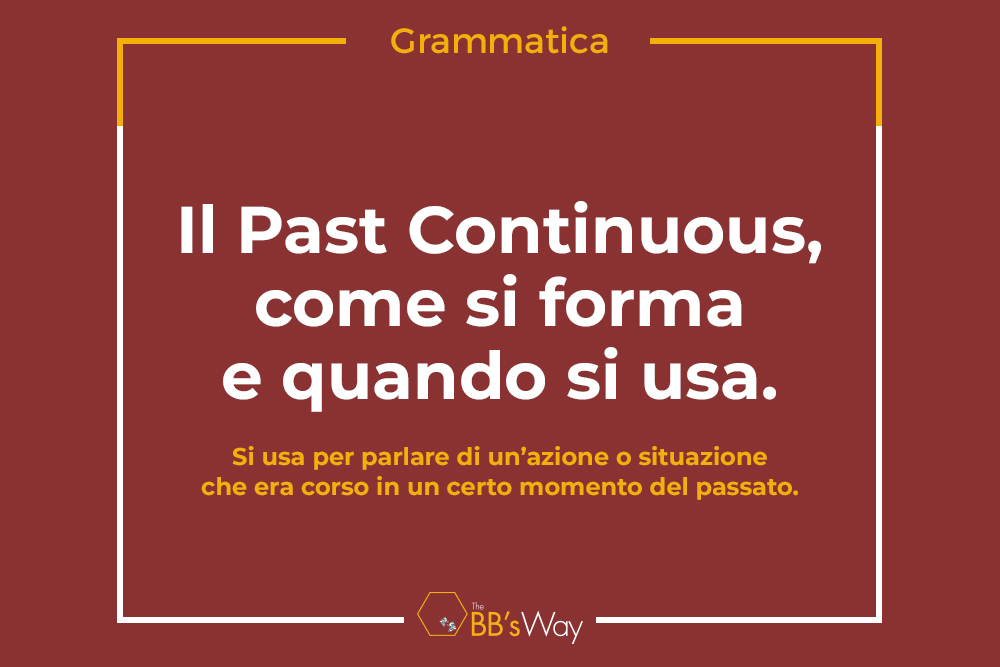Il Past Continuous, come si forma e quando si usa.
Magazine grammatica inglese Martedì, 29 Novembre 2022

Il past continuous si usa per parlare di un’azione o situazione che era in corso in un certo momento del passato. In quel determinato momento o periodo, l’azione era in corso, quindi era iniziata e non ancora finita.
Il past continuous si forma usando il verbo ausiliare was/were, ossia il passato del verbo essere e il gerundio del verbo principale, ossia la forma in -ing.
was/were + verb-ing
È importante ricordare che il verbo be è irregolare e si coniuga così:
- I was
- you were
- he/she/it was
- we were
- you were
- they were
Esempi:
At 8 o’clock, I was running in the park.
Alle 8, stavo correndo al parco.
This time last week we were shopping in Milan.
La settimana scorsa a quest’ora, stavamo facendo shopping a Milano.
She was talking to her best friend during lunchtime.
Stava parlando con la sua migliore amica durante il pranzo.
Per creare la forma negativa, si aggiunge not al verbo ausiliare was/were e si usa la forma contratta:
I wasn’t working yesterday afternoon.
Non stavo lavorando ieri pomeriggio.
They weren’t talking during the exam.
Loro non stavano parlando durante l’esame.
It wasn’t raining last Saturday.
Non stava piovendo sabato scorso.
Per creare la forma interrogativa, si inverte l’ordine del soggetto e del verbo essere, spostando quindi l’ausiliare was/were prima del soggetto.
Ricorda: Le domande con il verbo be non usano mai altri verbi ausiliari, come do, have, ecc.
Were you running in the park this morning?
Stavi correndo nel parco questa mattina?
What were you doing this time last week?
Cosa stavi facendo a quest’ora la settimana scorsa?
Who was she talking to during lunchtime?
Con chi stava parlando durante il pranzo?
Il past continuous si usa spesso insieme al past simple.
Quest’ultimo interrompe l’azione passata “in corso” al past continuous:
I was watching TV when my mother called.
Stavo guardando la TV quando mia mamma mi ha chiamato.
Per capire meglio questo ultimo punto, recupera il nostro articolo qui: Past simple e Past continuous
Ricorda: Alcuni verbi inglesi non si usano mai al gerundio (-ing form). Questi sono chiamati “verbi di stato” e li puoi trovare in questo articolo: Verbi di stato e come si usano
Esercizi:
Completa queste frasi usando il verbo tra parentesi al past continuous.
- It ___________ (rain) when I left home this morning.
- I ___________ (live) in Paris when I met them.
- What ___________ (do) at ten o’clock yesterday morning?
- Lots of people ___________ (wait) for the 6.30pm train yesterday evening.
- It was a sunny afternoon and people ___________ (walk) in the park.
Usa il past simple e il past continuous per creare frasi usando le parole tra parentesi.
- (I/see/an accident/whileI/wait/for the bus)
__________________________________________________________ - (It/start/raining/while/she/walk/home)
__________________________________________________________ - (I/watch/TV/when/my mother/call)
__________________________________________________________
Se non ti senti ancora sicuro, acquista uno dei nostri pacchetti da 10-15 ore e vieni a praticare con noi!
Scrivici subito a Questo indirizzo email è protetto dagli spambots. È necessario abilitare JavaScript per vederlo. per prenotare un test gratuito che valuti il tuo livello CEFR.
